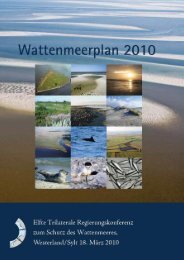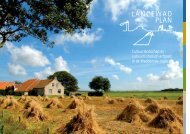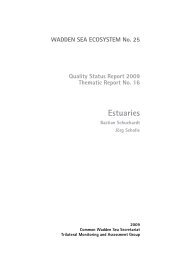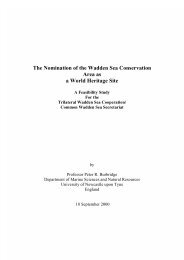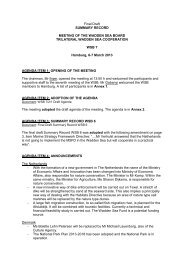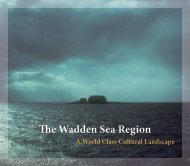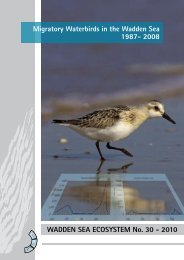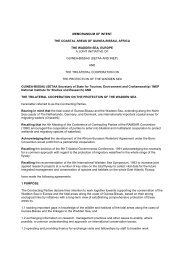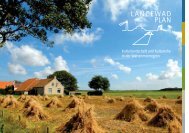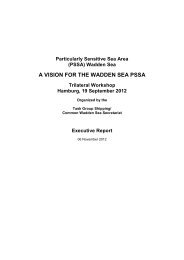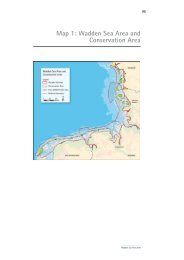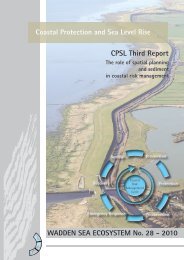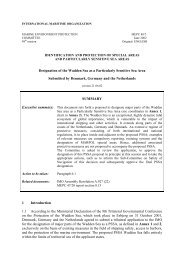Workshop Indicative Mapping - Trilateral Wadden Sea Cooperation
Workshop Indicative Mapping - Trilateral Wadden Sea Cooperation
Workshop Indicative Mapping - Trilateral Wadden Sea Cooperation
Create successful ePaper yourself
Turn your PDF publications into a flip-book with our unique Google optimized e-Paper software.
WORKSHOP INDICATIVE MAPPING<br />
Kreishaus Nordfriesland, Husum<br />
25 – 26 September 2012<br />
Summary Report
<strong>Workshop</strong> <strong>Indicative</strong> <strong>Mapping</strong>, draft summary record page 2<br />
Contents<br />
WORKSHOP INDICATIVE MAPPING .................................................................................................... 1<br />
1. WELCOME AND SETTING THE SCENE ........................................................................................... 3<br />
2. PRESENTATIONS .............................................................................................................................. 4<br />
2.1 Development Holocene period, the geological and geomorphological aspects .................. 4<br />
2.2 Use of remote sensing with historical data............................................................................... 5<br />
2.3 Habitation and use of the <strong>Wadden</strong> <strong>Sea</strong> from an archaeological perspective ........................ 5<br />
2.4 A natural history of the <strong>Wadden</strong> <strong>Sea</strong> ......................................................................................... 6<br />
2.5 Managing Cultural Heritage Under Water.................................................................................. 7<br />
2.6 Conservation and Management Schemes................................................................................. 7<br />
3. INDICATIVE MAPPING: DESIGNING A JOINT PROJECT PROPOSAL ......................................... 8<br />
3.1 Break-Out Sessions ..................................................................................................................... 8<br />
3.2 Project Proposal .......................................................................................................................... 9<br />
3.3 Working Steps .............................................................................................................................. 9<br />
4. CLOSING .......................................................................................................................................... 10<br />
Annex 1 List of participants ............................................................................................................... 11<br />
Annex 2 <strong>Workshop</strong> program .............................................................................................................. 13
<strong>Workshop</strong> <strong>Indicative</strong> <strong>Mapping</strong>, draft summary record page 3<br />
1. WELCOME AND SETTING THE SCENE<br />
The deputy director of the State Agency for Archaeology Schleswig-Holstein, Ulf Ickerodt,<br />
welcomed the participants and opened the workshop on the first day. A list of participants is<br />
in Annex 1. The programme for the workshop is in Annex 2. He particularly welcomed the<br />
president of the county council Nordfriesland, Mr. Pahl, who gave a short introduction about<br />
the county and its natural and cultural assets. He highlighted the rich cultural history of the<br />
area and explained the changing living conditions since the occupation by man. Mr. Pahl<br />
emphasised the need of scientific research to inventory, preserve and manage the cultural<br />
history. In this respect he mentioned the good cooperation with the State Agency for<br />
Archaeology and wished the workshop success and a good outcome.<br />
By a short presentation, Ulf Ickerodt introduced the objectives and the course of the<br />
workshop. Firstly, he referred to the cultural landscape projects, Lancewad and<br />
LancewadPlan, to explain the history and process of cooperation in landscape management.<br />
The increasing spatial requirements would make it necessary to document the<br />
archaeological sites with its values for better protection and management. In this respect, not<br />
only the vertical and horizontal (space) coherence but also the connection to seasonal and<br />
historic variations had to be taken into account. For a sound management, a good network<br />
and cooperation among the stakeholders as well as an acceptance of the public would be<br />
necessary. The approach of indicative mapping would be a good instrument to be used in<br />
management and preservation.<br />
The workshop chairman Jos Bazelmans from the Dutch Cultural Heritage Agency opened<br />
the presentations session of the workshop and pointed to the elaboration of a trilateral<br />
research plan. Firstly, he thanked all organizers (State Agency for Archaeology Schleswig-<br />
Holstein, CWSS, Cultural Heritage Agency of The Netherlands, WSF and Stichting<br />
Verdronken Geschiedenis) for their support to implement the workshop. The workshop was<br />
held in continuation of the workshops in Ribe (May 2011), Hannover (September 2011) and<br />
Amersfoort (January 2012). The goal was to address the values of the cultural maritime<br />
heritage of the <strong>Wadden</strong> <strong>Sea</strong> and to discuss methods to map the evidence of our cultural<br />
history.
<strong>Workshop</strong> <strong>Indicative</strong> <strong>Mapping</strong>, draft summary record page 4<br />
The statements of the Sylt Declaration (2010) would clearly ask for an analysis of the<br />
LancewadPlan strategy to integrate accepted parts into trilateral policy. As so far there would<br />
be no full common understanding of what indicative mapping encompasses and how it can<br />
be used in policy and management, a wider audience with non-experts should be involved in<br />
the process to get a broad commitment to the approach of indicative mapping. In order to get<br />
also commitment of the political level, a project plan should be presented at the <strong>Wadden</strong> <strong>Sea</strong><br />
Conference in February 2014. Jos Bazelmans emphasized the advantage of applying<br />
indicative mapping as it would be an excellent approach to map the "unknown" by predictive<br />
interpretations using e.g. (palaeo)- geomorphological data and archaeological research<br />
knowledge. He stimulated the workshop to work towards a trilateral indicative map for the<br />
archaeology of the <strong>Wadden</strong> <strong>Sea</strong> and pointed out contents and practical issues of the<br />
workshop.<br />
2. PRESENTATIONS<br />
2.1 Development Holocene period, the geological and geomorphological aspects<br />
Martina Karle (Lower Saxony Institute for Historical Coastal Research) and Henk Weerts<br />
(Cultural Heritage Agency of The Netherlands) introduced indicative mapping of the <strong>Wadden</strong><br />
<strong>Sea</strong> with a view on the geological perspective. They outlined the data availability and use,<br />
presented the Holocene paleogeography and the recent developments in 3-D mapping.<br />
Several categories of data were used to get a picture of the paleogeography. Borehole data<br />
from state agencies and oil/gas companies, archaeological information from various data<br />
bases, historical material, remote sensing data like laser altimetry as well as seismic data<br />
and last but not least expert knowledge in order to correctly interpret the data sets were<br />
taken into account.<br />
Detailed maps of the Holocene in the Netherlands illustrated the development of the<br />
landscape through time. Furthermore, results of the Jade Bay Project with a huge number of<br />
coring data contributed to a better understanding of transgression and regression of the sea<br />
in the coastal area. A number of maps, elaborated by Dirk Meier, visualized the landscape<br />
and settlement development at the North <strong>Sea</strong> Coast of Schleswig-Holstein from 6500 BC to<br />
today. Finally, the recent developments were presented in detailed 3-D mapping, using data<br />
and models from the Netherlands.
<strong>Workshop</strong> <strong>Indicative</strong> <strong>Mapping</strong>, draft summary record page 5<br />
2.2 Use of remote sensing with historical data<br />
Menne Kosian (Cultural Heritage Agency of The Netherlands) focused in his presentation on<br />
the use of remote sensing with historical data in the <strong>Wadden</strong> <strong>Sea</strong>. Only few landscapes<br />
would change more rapid than the marine. Sandbanks, channels and even complete<br />
coastlines could change dramatically overnight. This would be a threat not only for modern<br />
mariners; also our seafaring forefathers knew this problem also all very well. These changes<br />
could be monitored with modern techniques and be used to adapt the available maps on a<br />
regular basis. In order to avoid possible threats to wreck sites, knowledge would be required<br />
to get an idea of underwater landscape in various periods and the changes over time.<br />
Historic cartographical analysis could provide an insight in historical use and sometimes in<br />
the morphology of former landscapes. But the analysis would only provide qualitative<br />
information; i.e. descriptive data (map legends, interpretations, names or remarks). Modern<br />
remote-sensing devices would provide purely quantitative data. In order to model these<br />
changes overtime, the historical qualitative data should be in some way ‘quantified’ to make<br />
calculations possible. If the historical records could provide quantitative data as well, it<br />
should somehow be extrapolated to be comparable with modern high resolution data. This<br />
‘quantifying’ of data could also be used for modern qualitative maps, such as soil type maps<br />
or land use maps.<br />
2.3 Habitation and use of the <strong>Wadden</strong> <strong>Sea</strong> from an archaeological perspective<br />
Martin Segschneider from the State Agency for Archaeology Schleswig-Holstein gave a<br />
presentation about habitation and use of the <strong>Wadden</strong> <strong>Sea</strong> from an archaeological<br />
perspective. Some illustrations showed vividly the settlement area in the southern North <strong>Sea</strong><br />
after the last Ice Age as well as activities of the former inhabitants. Humans roamed the<br />
landscape for hunting and collecting wood, still visible in the flint tools to be found. With the<br />
sea level rise, the forests were flooded and drowned; only in the Iron Age, marsh surfaces<br />
were inhabited again. Following, he presented places of archaeological finds of the Stone<br />
Age in the <strong>Wadden</strong> <strong>Sea</strong>. These were finds from the Bell Beaker culture, flint stones and<br />
remains from the ancient fauna.
<strong>Workshop</strong> <strong>Indicative</strong> <strong>Mapping</strong>, draft summary record page 6<br />
Of particular interest were evidences of old dwelling mounds in the <strong>Wadden</strong> <strong>Sea</strong> with traces<br />
like wattle works, fortifications and graves. Important finds were made along the coast of<br />
Lower Saxony. Many finds of the Roman Empire around the island of Föhr documented<br />
vividly the historic development with settlements and trade. Also remains of wells in the<br />
<strong>Wadden</strong> <strong>Sea</strong> underlined the habitation period of this area. Evidences of former dikes,<br />
drainage systems and field patterns in the intertidal <strong>Wadden</strong> <strong>Sea</strong> bear witnesses of the<br />
manifold uses in historic times. Aerial photographs were an excellent instrument to discover<br />
these remains. With a historic map of the coastal area of Schleswig-Holstein, encompassing<br />
settlements, archaeological remains, uses and trade witnesses he finally illustrated the vivid<br />
history. Finally, he pointed at the "<strong>Wadden</strong> <strong>Sea</strong> project" of the Lower Saxony Institute for<br />
Historical Coastal Research, which elaborates on a systematic inventory of sites of finds in<br />
the <strong>Wadden</strong> <strong>Sea</strong>. A flyer of the project was distributed.<br />
2.4 A natural history of the <strong>Wadden</strong> <strong>Sea</strong><br />
The second day of the workshop commenced with a presentation of Karsten Reise of the<br />
Alfred Wegner Institute, Coastal Ecology <strong>Wadden</strong> <strong>Sea</strong> Station Sylt, on the natural history of<br />
the <strong>Wadden</strong> <strong>Sea</strong>. The <strong>Wadden</strong> <strong>Sea</strong> is a relatively young system created as a result of the<br />
rapid sea level increase in the Holocene period. The current <strong>Wadden</strong> <strong>Sea</strong> exists because the<br />
sediment import balances the sea level rise of some 15 cm per century. The cause and effect<br />
chain is however almost never sufficient to explain developments with regard to the <strong>Wadden</strong><br />
<strong>Sea</strong>. Contingency is an inherent part of the system, historic developments could help explain<br />
developments such as the losses of species as the sting ray, thornback ray and sturgeon or<br />
changes in species. E.g. grey seals were much more abundant in the past than harbour<br />
seals. The appearance of new alien species as the pacific oyster was irreversible. A natural<br />
balance never existed and never will exist primarily because the impact of man and therefore<br />
focus should be on contingency and the scale and pace of man´s interference in the system.<br />
Through the designation as a World Heritage property, the <strong>Wadden</strong> <strong>Sea</strong> has become a<br />
heritage of mankind, a treasure to be looked after. Therefore it is important to study also in a<br />
historic perspective how the <strong>Wadden</strong> <strong>Sea</strong> is adapting to developments.
<strong>Workshop</strong> <strong>Indicative</strong> <strong>Mapping</strong>, draft summary record page 7<br />
2.5 Managing Cultural Heritage Under Water<br />
Will Brouwers (Cultural Heritage Agency of The Netherlands) briefly introduced the MACHU<br />
project (Managing Cultural Heritage Under Water) and the use of its data base. The project<br />
made information available for researchers, policymakers and the general public. This was<br />
achieved through a web-based GIS application and an interactive website. Detailed<br />
information about the project and the use of the data base can be found under:<br />
http://www.machuproject.eu/documenten/MACHU_report_3.pdf<br />
2.6 Conservation and Management Schemes<br />
Jörn Kohlus, <strong>Wadden</strong> <strong>Sea</strong> National Park Authority Schleswig-Holstein, and J. Opdebeeck,<br />
Cultural Heritage Agency of The Netherlands, briefly presented the conservation and<br />
management schemes of the <strong>Wadden</strong> <strong>Sea</strong> Conservation Area. The very comprehensive<br />
protection and management system in place provides a firma basis for an integration of the<br />
protection and management of the maritime cultural heritage. The indicative mapping would<br />
be of interest for both sectors and would meet the need for a better integration.
<strong>Workshop</strong> <strong>Indicative</strong> <strong>Mapping</strong>, draft summary record page 8<br />
3. INDICATIVE MAPPING: DESIGNING A JOINT PROJECT PROPOSAL<br />
After the presentations the workshop continued with discussing indicative mapping in three<br />
groups and plenary. The objective was to come to an agreement on the outline of a common<br />
project between the responsible authorities and other partners that could be further<br />
developed in the coming period including funding possibilities. The project should also be<br />
submitted to the 2014 <strong>Trilateral</strong> Governmental Conference, the <strong>Wadden</strong> <strong>Sea</strong> Ministerial<br />
Conference, which will be held in Tønder 4-6 February 2014 and constitute the input of the<br />
LancewadPlan follow up.<br />
3.1 Break-Out Sessions<br />
During two break-out sessions the needs (rationale) and perspectives of a common project<br />
and the output and involvement in terms of who should and could participate in such a<br />
project were discussed. The results of the debate were reported back and discussed in detail<br />
in plenary. Overall the workshop agreed that the indicative mapping would be an urgent and<br />
a very useful tool for policy making and management of the maritime cultural heritage of the<br />
<strong>Wadden</strong> <strong>Sea</strong> also in terms of integration with the protection and management of the natural<br />
values of the <strong>Wadden</strong> <strong>Sea</strong>. There was also consensus that such a project proposal could<br />
constitute an important input to the 2014 <strong>Wadden</strong> <strong>Sea</strong> Conference.<br />
Some reservations were expressed, however, by the participants whether it would be<br />
possible to formulate a common project on the basis of the existing knowledge level and<br />
policy and management approach:<br />
There is so far still no full common understanding of what indicative mapping<br />
encompasses and how it can be used in policy making and management;<br />
There are differences in terms of the responsibilities with regard to in particular spatial<br />
planning, management approaches and possibilities etc. and therefore also to how<br />
such an instrument can be used regionally;<br />
The data quality and data availability is very different between the regions; the<br />
elaboration of comparable indicative maps requires a certain degree of harmonization<br />
of the data and the attainment of new data which is potentially very expensive;<br />
It is unclear to make an approximation of how much such a project will cost and<br />
whether the resources will be available;<br />
A feasibility study is therefore needed. First, however, this approach needs to be<br />
discussed further in detail with the responsible authorities and a common<br />
understanding has to be reached both in terms of the technical details as well as the<br />
more policy oriented issues.
<strong>Workshop</strong> <strong>Indicative</strong> <strong>Mapping</strong>, draft summary record page 9<br />
3.2 Project Proposal<br />
There was agreement that the above mentioned concerns could be cleared up and that the<br />
process should be continued with the aim to present a project proposal to the 2014 <strong>Wadden</strong><br />
<strong>Sea</strong> Conference and constitute the input with regard to the cultural landscape discussion at<br />
the Conference. It was agreed to aim at the following targets:<br />
<br />
<br />
<br />
<br />
Visualization of geomorphological changes in the <strong>Wadden</strong> <strong>Sea</strong> and, as a<br />
consequence of this, also of the changes in archaeological values as well as the<br />
threats of further degradation and/or loss;<br />
Provision of maps for management and use;<br />
Usage of indicative mapping to visualize the values also with regard to historical time<br />
depths as well as for awareness;<br />
Increased historic awareness of the population of the coastal region.<br />
3.3 Working Steps<br />
On the proposal of the chairman the following work steps and process was agreed which<br />
should result in the delivery of a draft project proposal (outline) for the 2014 <strong>Wadden</strong> <strong>Sea</strong><br />
Conference to be delivered in time for its preparation in June 2013:<br />
(1) Implementation of a data delivery workshop to discuss the availability and the quality<br />
of the data as well as technical aspects for common use. Also the use of the data<br />
system of the European MACHU project will be considered. Furthermore, the data<br />
reliability with regard to geology, archaeology and ecology should be assessed.<br />
Finally, the exchange of data with a view to assess the feasibility of a common data<br />
approach method including gaps and shortages will be explored. The workshop<br />
would be preceded by a study of the data availability on short term;
<strong>Workshop</strong> <strong>Indicative</strong> <strong>Mapping</strong>, draft summary record page 10<br />
(2) As a next step a pre-project plan with different work packages (themes) such as<br />
methodology, data quality, geology of Holocene deposits, assessment of erosion and<br />
sedimentation in different tidal basins will be elaborated. The project plan will<br />
encompass indicative mapping of all tidal basins on a quality base as well as a focus<br />
on a quantitative base for a few tidal basins. For these, a comparative study could be<br />
included. To proceed, by mid November 2012 a first draft outline of the project should<br />
be circulated to a wider group (participants Ribe workshop 2011) and solicit<br />
comments and further suggestions.<br />
(3) On the basis of this, an information workshop on indicative mapping with a wider<br />
audience will be convened on 20 February 2013 to get a common understanding of<br />
the appropriate usage of the method for policy, management and awareness.<br />
(4) The finalization of the project indicative mapping will take place on a workshop in<br />
May-June 2013. In order to integrate the project in a cultural heritage and landscape<br />
perspective also for the future, this workshop will be implemented in the framework of<br />
annual workshops. Following, other overall themes, such as how to manage the<br />
cultural landscape with a decreasing population, will also be part of the workshop.<br />
The work steps will be organized by a core group, represented by Jos Bazelmans, Karel<br />
Essink, Hauke Jöns, Ulf Ickerodt, Martijn Manders, Anne Husum Marboe, Jens Enemark and<br />
Manfred Vollmer.<br />
Finally, the secretary informed that as a follow-up of the Ribe workshop last year a popular<br />
version of the comparative analysis will be published on the occasion of the International<br />
Scientific <strong>Wadden</strong> <strong>Sea</strong> Symposium, 21-23 November 2012 in all four languages (English,<br />
German, Danish, Dutch). The publication is a joint publication of the Dutch <strong>Wadden</strong><br />
Academy and the CWSS and directed at policy makers, managers, historic associations etc.<br />
He requested help in circulating the publication to a wider audience.<br />
4. CLOSING<br />
The chairman closed the workshop at 16:00 hrs and thanked the participants for their<br />
constructive contributions and fruitful discussions. In his view this workshop had reinforced<br />
the trans-boundary cooperation on the cultural heritage of the <strong>Wadden</strong> <strong>Sea</strong> Region and he<br />
was confident that a common project on indicative mapping could be elaborated and<br />
implemented. He looked forward to the next steps and wished the participants a safe journey<br />
home.
<strong>Workshop</strong> <strong>Indicative</strong> <strong>Mapping</strong>, draft summary record page 11<br />
Annex 1 List of participants<br />
Mr. Prof.Dr. Jos Bazelmans<br />
Rijksdienst voor het Cultureel Erfgoed<br />
Postbus 1600<br />
NL-3800 BP Amersfoort<br />
phone: +31 (033) 4217421<br />
e-mail: j.bazelmans@cultureelerfgoed.nl<br />
Mr. Will Brouwers<br />
RCE Maritiem Programma<br />
Postbus 1600<br />
NL-3800 BP Amersfoort<br />
Mr. Jens Enemark<br />
Common <strong>Wadden</strong>sea Secretariat<br />
Virchowstr. 1<br />
D - 26382 Wilhelmshaven<br />
phone: +49 (04421) 9108 12<br />
e-mail: enemark@waddensea-secretariat.org<br />
Mr. Mike Belasus<br />
Deutsches Schiffahrtsmuseum<br />
Hans-Scharoun-Platz 1<br />
D- 27568 Bremerhaven<br />
phone: +49 (0471) 48207 28<br />
e-mail: belasus@dsm.museum<br />
Mr. Bo Ejstrud<br />
Marine Archaeology, University of Southern Denmark<br />
Niels Bohrs Vej 9<br />
DK - 6700 Esbjerg<br />
e-mail: ejstrud@hist.sdu.dk<br />
Mr. Karel Essink<br />
Stichting Verdronken Geschiedenis<br />
Vosbergerlaan 14<br />
NL - 9761 AK Eelde<br />
e-mail: karelessink@hetnet.nl<br />
Mr. Steen Frydenlund Jensen<br />
Sydvestjyske Museer<br />
Odins Plads 0<br />
DK - 6759 Ribe<br />
phone: +45 76 16 39 69<br />
e-mail: stj@sydvestjyskemuseer.dk<br />
Mr. Axel Heinze<br />
Museum ‚Leben am Meer’ Esens<br />
Jahnstraße 7<br />
D - 26427 Esens<br />
e-mail: axel.heinze@gmx.de<br />
Ms Martina Karle<br />
Niedersächsisches Institut für historische<br />
Küstenforschung<br />
Victoriastraße 26/28<br />
D - 26382 Wilhelmshaven<br />
phone: +49 (04421) 915156<br />
e-mail: karle@nihk.de<br />
Mr. Jörn Kohlus<br />
Landesbetrieb für Küstenschutz, Nationalpark und<br />
Meeresschutz Schleswig-Holstein<br />
Schloßgarten 1<br />
D - 25832 Tönning<br />
phone: +49 (04861) 61646<br />
e-mail: joern.kohlus@lkn.landsh.de<br />
Mr. Henk Weerts<br />
Rijksdienst voor het Cultureel Erfgoed<br />
Postbus 1600<br />
NL-3800 BP Amersfoort<br />
e-mail: h.weerts@cultureelerfgoed.nl<br />
Mr. Dr. Henning Haßmann<br />
Nds. Landesamt für Denkmalpflege<br />
Scharnhorststraße 1<br />
D - 30175 Hannover<br />
phone: +49 (0511)925 5265<br />
e-mail:<br />
henning.hassmann@nld.niedersachsen.de<br />
Mr. Ulf Ickerodt<br />
Archäologisches Landesamt Schleswig-Holstein<br />
Brockdorff-Rantzau-Straße 70<br />
D - 24837 Schleswig<br />
phone: +49 (04621) 38737<br />
e-mail: Ulf.Ickerodt@alsh.landsh.de<br />
Ms Sunhild Kleingärtner<br />
Niedersächsisches Institut für historische<br />
Küstenforschung<br />
Viktoriastr. 26/28<br />
D - 26382 Wilhelmshaven<br />
phone: +49 (04421) 915113<br />
e-mail: kleingaertner@nihk.de<br />
Mr. Menne Kosian<br />
Rijksdienst voor het Cultureel Erfgoed<br />
Postbus 1600<br />
NL-3800 BP Amersfoort<br />
e-mail: m.kosian @cultureelerfgoed.nl<br />
Mr. Anders Olesen<br />
Sydvestjyske Museer<br />
Odins Plads 1<br />
DK - 6760 Ribe<br />
phone: +45 76 16 39 70<br />
e-mail: anol@sydvestjyskemuseer.dk
<strong>Workshop</strong> <strong>Indicative</strong> <strong>Mapping</strong>, draft summary record page 12<br />
Mr. Johan Opdebeeck<br />
RCE Maritiem Programma<br />
Postbus 1600<br />
NL-3800 BP Amersfoort<br />
phone:<br />
e-mail: j.opdebeeck@cultureelerfgoed.nl<br />
Mr. Holger Schweitzer<br />
Marine Archaeology, University of Southern Denmark<br />
Niels Bohrs Vej 9<br />
DK - 6700 Esbjerg<br />
phone:<br />
e-mail: holger@hist.sdu.dk<br />
Mr. Dr. Sven-Hinrich Siemers<br />
Museumsverbund Nordfriesland<br />
Herzog-Adolf-Straße 25<br />
D - 25813 Husum<br />
phone: +49 (04841) 2545<br />
e-mail:<br />
siemers@museumsverbund-nordfriesland.de<br />
Mr. Armin Volkmann<br />
Julius-Maximilians-Universität Würzburg, Digital<br />
Humanities<br />
Am Hubland<br />
D - 97074 Würzburg<br />
phone: + 49 (0931) 3185825<br />
e-mail: armin.volkmann@uni-wuerzburg.de<br />
Mr. Karsten Reise<br />
AWI, Wattenmeerstation Sylt<br />
Havenstraße 43<br />
D - 25992 List/ Sylt<br />
phone: +49 (04651) 956 4304<br />
e-mail: karsten.reise@awi.de<br />
Mr. Martin Segschneider<br />
Achäologisches Landesamt Schleswig<br />
Brockdorff-Rantzau-Straße 70<br />
D - 24837 Schleswig<br />
phone: +49 (04621) 38728<br />
e-mail: martin.segschneider@alsh.landsh.de<br />
Ms Martina Tammen<br />
Museum ‚Leben am Meer’ Esens<br />
Jahnstraße 6<br />
D - 26426 Esens<br />
Mr. Manfred Vollmer<br />
<strong>Wadden</strong> <strong>Sea</strong> Forum<br />
Virchowstr. 1<br />
D - 26382 Wilhelmshaven<br />
phone: + 49 (04421) 9108 18<br />
e-mail: vollmer@waddensea-forum.org
<strong>Workshop</strong> <strong>Indicative</strong> <strong>Mapping</strong>, draft summary record page 13<br />
Annex 2 <strong>Workshop</strong> program<br />
Objectives <strong>Workshop</strong><br />
The workshop will introduce the method of indicative mapping in a maritime context and will<br />
reflect the development of the Holocene period and the use of the maritime heritage in<br />
historic times. On the basis of this, three main objectives will lead through the workshop:<br />
(1) Acceptance of indicative mapping as an approach and use in conservation,<br />
management and spatial planning<br />
(2) Outline of a common project indicative mapping supported by partners<br />
(3) Integration of conservation and heritage approaches<br />
The workshop will also aim at a broad commitment of the authorities/organisations for the<br />
further elaboration on the maritime heritage to commonly protect our cultural heritage.<br />
Overall Programme Schedule<br />
24 September<br />
12:00 – 13:00 Arrival in Husum<br />
Meeting at the Nordsee-Museum near the<br />
central station<br />
13:00 – 18:00 Excursion Excursion to Nordstrand / <strong>Wadden</strong> <strong>Sea</strong><br />
25 September<br />
09:00 Meeting Meeting at the Nordsee-Museum, Husum<br />
09:30 – 11:30 Nordsee Museum<br />
Visit of the <strong>Wadden</strong> <strong>Sea</strong> exhibitions in the<br />
Nordsee-Museum<br />
11:30 – 12:00 Walk to the Kreishaus Husum<br />
12:00 – 13:00 LUNCH with registration of participants<br />
13:00 – 13:30<br />
Official welcome to workshop by the<br />
Kreis Nordfriesland and the State<br />
Service for Archaeology<br />
Mr. Pahl<br />
Mr. Ulf Ickerodt<br />
13:30 – 17:30 PRESENTATIONS Session chair: Jos Bazelmans<br />
Towards a trilateral research plan?<br />
Development Holocene period, the<br />
geological and geomorphological<br />
aspects<br />
Use of remote sensing with<br />
historical data<br />
Jos Bazelmans<br />
Ms Martina Karle<br />
Mr. Henk Weert<br />
Mr. Menne Kosian
<strong>Workshop</strong> <strong>Indicative</strong> <strong>Mapping</strong>, draft summary record page 14<br />
15:00 – 15:30 COFFEE BREAK<br />
13:30 – 17:30 PRESENTATIONS continued Session chair: Jos Bazelmans<br />
Habitation and use of the <strong>Wadden</strong><br />
<strong>Sea</strong> from an archaeological<br />
perspective<br />
Summary, discussion, ambition level<br />
common project indicative mapping<br />
Mr. Martin Segschneider<br />
Chair: Mr. Jos Bazelmans<br />
18:00 – 20:30 DINNER State Archaeological Service<br />
26 September<br />
09:00 – 09:45<br />
PRESENTATION:<br />
A natural history of the <strong>Wadden</strong> <strong>Sea</strong><br />
Discussion in 3-4 groups in breakout<br />
sessions with a view to discuss and<br />
define the elements of a common<br />
project on indicative mapping of the<br />
archaeological heritage in the<br />
<strong>Wadden</strong> <strong>Sea</strong><br />
Mr. Karsten Reise<br />
09:45 – 10:45 Break out session 1:<br />
Discussion needs and rationale<br />
Perspectives<br />
10:45 – 11:00 Reflection by plenary<br />
Chairs breakout sessions<br />
11:00 – 11:30 COFFEE BREAK<br />
11:30 – 12:30<br />
Break out session 2:<br />
<br />
<br />
Discussion on end<br />
product/output<br />
Who should be<br />
involved/organizational matters<br />
12:30 – 12:45 Reflection by plenary<br />
12:45 – 13:45 LUNCH<br />
13:45 – 15:15<br />
<br />
<br />
Presentation results breakout<br />
sessions<br />
Elements and development of<br />
joint project<br />
Mr. Jos Bazelmans<br />
15:15 – 15:45 COFFEE BREAK<br />
15:45 – 16:45<br />
<br />
Discussion integration nature<br />
conservation – maritime heritage<br />
conservation – common efforts<br />
Presentation of the protection and<br />
management of the <strong>Wadden</strong> <strong>Sea</strong><br />
from the 4 regions with specific<br />
emphasis on the integration of the<br />
archaeological values<br />
Chair: Mr. Jos Bazelmans<br />
Mr. Johan Opdebeeck<br />
Mr. Jörn Kohlus<br />
16:45 – 17:15 Follow up organizationally<br />
17:15 – 17:30<br />
<br />
Concluding presentation on<br />
maritime archaeology, the<br />
greater perspective<br />
17:30 END OF CONFERENCE<br />
Mr. Ulf Ickerodt
<strong>Workshop</strong> <strong>Indicative</strong> <strong>Mapping</strong>, draft summary record page 15<br />
Works



